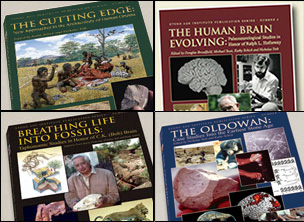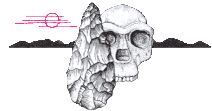The Stone Age Institute Press:
The Cutting Edge
![]()
The Cutting Edge: New Approaches to the Archaeology of Human Origins, 2009
(355 pages)
Edited by Kathy Schick and Nicholas Toth
This book focuses on innovative new approaches to the archaeological evidence for protohuman behavior found in the Early Stone Age, based on a recent international conference held at the Stone Age Institute. Major researchers in the field present important new findings from a range of well-preserved archaeological sites and critical experimental archaeological investigations. Topics include: early stone artifact assemblage variability at Gona, Ethiopia and at Koobi Fora, Kenya; early human presence in North Africa; technological strategies and patterns at Peninj, Tanzania; the Oldowan industries from Sterkfontein Cave, South Africa ; flaking accidents and knapping skills at Hadar, Ethiopia; hominin transport of stone at Olduvai Gorge, Tanzania; a critical examination of the early occupation of India; new methods for quantifying stone tool cutting efficiency in the Oldowan and Acheulean; evidence for early occupation Eurasia, with particular attention to early sites in Spain, as well as early hominin presence in China in the Nihewan Basin; a comparative experimental study of Oldowan artifacts made by novices and by expert toolmakers; and experimental zooarchaeology with regard to the anatomical patterning of butchery marks.
This beautifully illustrated hard bound volume may be purchased through Amazon.
The Cutting Edge is now available for download:
Download the book as a single complete pdf:
The Cutting Edge Complete PDF (17 MB)
Or download selected chapter pdf's:
Introductions and Table of Contents
Chapter 1: Changes in Hominin Trasnport of Stone for Oldowan Tools across the Eastern Olduvai Basin During Lowermost Bed II Times (Robert J. Blumenschine, Fidelis T. Masao and Ian G. Stanistreet)
Chapter 2: Plio-Pleistocene Technological Variation: A View from the KBS Mbr., Koobi Fora Formation (David R. Braun & John W. K. Harris)
Chapter 3: Was There an Oldowan Occupation in the Indian Subcontinent? (Parth R. Chauhan)
Chapter 4: Archaic Stone Industries from East Africa and Southern Europe: Pre-Oldowan and Oldowan (Henry de Lumley, Deborah Barsky, and Dominique Cauche)
Chapter 5: Technological Strategies in the Lowere Pleistocene at Peninj, West of Lake Natron, Tanzania (Ignacio de la Torre)
Chapter 6: The Oldest Occupation of Europe: Evidence from Southern Spain (Beatriz Fajardo)
Chapter 7: Learning from Mistakes: Flaking Accidents and Knapping Skills in the Assemblages of A.L. 894, Hadar, Ethiopia (Erella Hovers)
Chapter 8: The Oldowan Industry from Sterkfontein Caves, South Africa (K. Kuman & A. S. Field)
Chapter 9: Experimental Zooarchaeology and Its Role in Defining the Investigative Parameters of the Behavior of Early Stone Age Hominids (Travis Rayne Pickering & Charles P. Egeland)
Chapter 10: The Oldowan in North Africa within a Biochronological Framework (Mohamed Sahnouni & Jan van der Made)
Chapter 11: Insights into Late Pliocene Lithic Assemblage Variability: The East Gona and Ounda Gona South Oldowan Archaeology (2.6 Million Years Ago), Afar, Ethiopia (Sileshi Semaw, Michael J. Rogers, and Dietrich Stout)
Chapter 12: Understanding Oldowan Knapping Skill: An Experimental Study of Skill Acquisition in Modern Humans (Dietrich Stout, Kathy Schick, and Nicholas Toth)
Chapter 13: The Importance of Actualistic Studies in Early Stone Age Research : Some Personal Reflections (Nicholas Toth & Kathy Schick)


